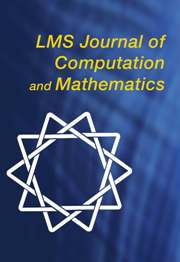Article contents
Constructing supersingular elliptic curves with a given endomorphism ring
Published online by Cambridge University Press: 01 August 2014
Abstract
Let  $\def \xmlpi #1{}\def \mathsfbi #1{\boldsymbol {\mathsf {#1}}}\let \le =\leqslant \let \leq =\leqslant \let \ge =\geqslant \let \geq =\geqslant \def \Pr {\mathit {Pr}}\def \Fr {\mathit {Fr}}\def \Rey {\mathit {Re}}\mathcal{O}$ be a maximal order in the quaternion algebra
$\def \xmlpi #1{}\def \mathsfbi #1{\boldsymbol {\mathsf {#1}}}\let \le =\leqslant \let \leq =\leqslant \let \ge =\geqslant \let \geq =\geqslant \def \Pr {\mathit {Pr}}\def \Fr {\mathit {Fr}}\def \Rey {\mathit {Re}}\mathcal{O}$ be a maximal order in the quaternion algebra  $B_p$ over
$B_p$ over  $\mathbb{Q}$ ramified at
$\mathbb{Q}$ ramified at  $p$ and
$p$ and  $\infty $. The paper is about the computational problem: construct a supersingular elliptic curve
$\infty $. The paper is about the computational problem: construct a supersingular elliptic curve  $E$ over
$E$ over  $\mathbb{F}_p$ such that
$\mathbb{F}_p$ such that  ${\rm End}(E) \cong \mathcal{O}$. We present an algorithm that solves this problem by taking gcds of the reductions modulo
${\rm End}(E) \cong \mathcal{O}$. We present an algorithm that solves this problem by taking gcds of the reductions modulo  $p$ of Hilbert class polynomials.
$p$ of Hilbert class polynomials.
New theoretical results are required to determine the complexity of our algorithm. Our main result is that, under certain conditions on a rank three sublattice  $\mathcal{O}^T$ of
$\mathcal{O}^T$ of  $\mathcal{O}$, the order
$\mathcal{O}$, the order  $\mathcal{O}$ is effectively characterized by the three successive minima and two other short vectors of
$\mathcal{O}$ is effectively characterized by the three successive minima and two other short vectors of  $\mathcal{O}^T\! .$ The desired conditions turn out to hold whenever the
$\mathcal{O}^T\! .$ The desired conditions turn out to hold whenever the  $j$-invariant
$j$-invariant  $j(E)$, of the elliptic curve with
$j(E)$, of the elliptic curve with  ${\rm End}(E) \cong \mathcal{O}$, lies in
${\rm End}(E) \cong \mathcal{O}$, lies in  $\mathbb{F}_p$. We can then prove that our algorithm terminates with running time
$\mathbb{F}_p$. We can then prove that our algorithm terminates with running time  $O(p^{1+\varepsilon })$ under the aforementioned conditions.
$O(p^{1+\varepsilon })$ under the aforementioned conditions.
As a further application we present an algorithm to simultaneously match all maximal order types with their associated  $j$-invariants. Our algorithm has running time
$j$-invariants. Our algorithm has running time  $O(p^{2.5 + \varepsilon })$ operations and is more efficient than Cerviño’s algorithm for the same problem.
$O(p^{2.5 + \varepsilon })$ operations and is more efficient than Cerviño’s algorithm for the same problem.
MSC classification
- Type
- Research Article
- Information
- LMS Journal of Computation and Mathematics , Volume 17 , Special Issue A: Algorithmic Number Theory Symposium XI , 2014 , pp. 71 - 91
- Copyright
- © The Author(s) 2014
References
- 8
- Cited by


